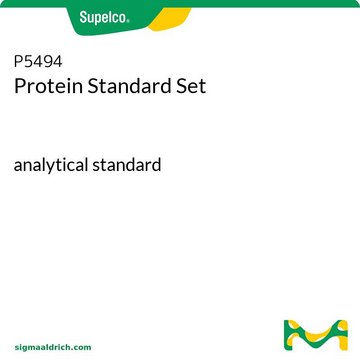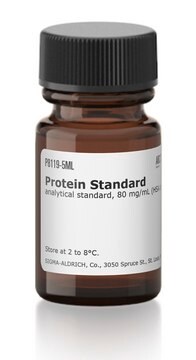P5369
Protein Standard
analytical standard, 200 mg/mL (BSA)
Sign Into View Organizational & Contract Pricing
All Photos(1)
About This Item
UNSPSC Code:
85151701
NACRES:
NA.24
Recommended Products
grade
analytical standard
Quality Level
contains
0.1% sodium azide as preservative
analyte chemical class(es)
amino acids, peptides, proteins
concentration
200 mg/mL (BSA)
technique(s)
gel permeation chromatography (GPC): suitable
application(s)
food and beverages
format
single component solution
storage temp.
2-8°C
Application
This analyticalstandard was used as follows:
- Preparation of calibration curves in the protein assay ofsix edible fishes commonly consumed in the United Arab Emirates using FolinPhenol reagent
- Determinationof protein concentration in the study of structural and functional characterizationof an industrially produced endo-1,4-β-xylanase (ENDO-I) using differentchromatographic techniques combined with mass spectrometric detection
Other Notes
Bovine serum albumin in saline
related product
Product No.
Description
Pricing
Storage Class Code
10 - Combustible liquids
WGK
WGK 3
Flash Point(F)
Not applicable
Flash Point(C)
Not applicable
Personal Protective Equipment
dust mask type N95 (US), Eyeshields, Gloves
Choose from one of the most recent versions:
Already Own This Product?
Find documentation for the products that you have recently purchased in the Document Library.
Siu Hung Joshua Chan et al.
PloS one, 9(3), e92256-e92256 (2014-03-19)
Acetate kinase (ACK) (EC no: 2.7.2.1) interconverts acetyl-phosphate and acetate to either catabolize or synthesize acetyl-CoA dependent on the metabolic requirement. Among all ACK entries available in UniProt, we found that around 45% are multiple ACKs in some organisms including
M Verhegghe et al.
Journal of dairy science, 100(5), 3497-3512 (2017-03-21)
The aim of this study was to develop and validate 2 protocols (for use on-farm and at a central location) for the reduction of Mycobacterium avium ssp. paratuberculosis (MAP) in colostrum while preserving beneficial immunoglobulins (IgG). The on-farm protocol was
Mafalda Cavalheiro et al.
Communications biology, 4(1), 886-886 (2021-07-22)
Candida glabrata is an opportunistic pathogen that adheres to human epithelial mucosa and forms biofilm to cause persistent infections. In this work, Single-cell Force Spectroscopy (SCFS) was used to glimpse at the adhesive properties of C. glabrata as it interacts
Validated method for estimation of total flavonoids in Romanian propolis
Marghitas, et al.
Bulletin UASVM Food Science and Technology, 63, 64-64 (2007)
Inactivation of genes TEC1 and EFG1 in
Beatriz Helena Dias Panariello et al.
Journal of oral microbiology, 9(1), 1385372-1385372 (2017-10-31)
Our team of scientists has experience in all areas of research including Life Science, Material Science, Chemical Synthesis, Chromatography, Analytical and many others.
Contact Technical Service








